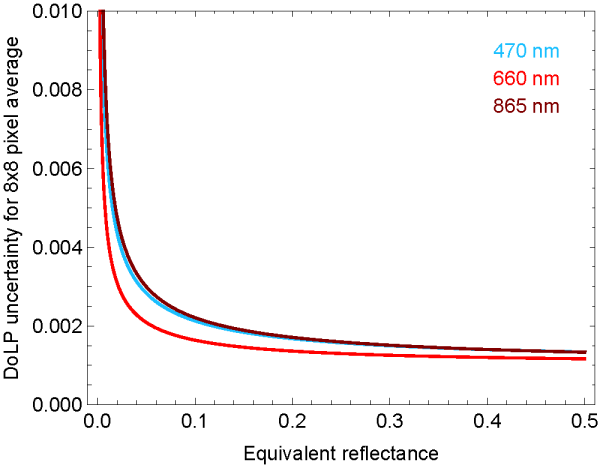The Airborne Multi-angle SpectroPolarimetric Imager (AirMSPI) is a multi-spectral pushbroom imaging polarimeter with eight spectral channels whose bandpass is centered between 355 and 935nm. Dual photoelastic modulators, quarter-wave plates and wire-grid polarizers provide sensitivity to linear polarization in three spectral channels (470, 660 and 865nm). The AirMSPI camera is mounted on a single axis gimbal with a +/- 67˚ along track range. Currently, two acquisition modes are used. The "step and stare" mode repeatedly targets the same region, which is observed at multiple viewing angles. Typically, nine views are captured, although this can be increased at the expense of along-track scene coverage. For the "continuous sweep" mode, the gimbal slews back and forth. This results in more along track coverage, but with a single (and variable) viewing angle for each pixel. The AirMSPI instrument has an IFOV of 0.345mrad and a frame time of 43.5msec. For the ER-2 aircraft used during PODEX and SEAC4RS (altitude of 19800m, speed 207m/sec), this translates to a native pixel resolution of 7m with 9m of along track "smear". Data are gridded to 10m for the "step and stare" mode, and 25m for the "continuous sweep" mode.
AirMSPI-2 is a second generation instrument with additional channels in the SWIR and two channels in and near the Oxygen-A band. The shortest polarization sensitive channel is at 445nm, and the two shortest wavelengths are at 365 and 385nm. Other characteristics are similar to AirMSPI.
Image: AirMSPI nadir imagery of Fresno, CA, acquired on 6 January 2012. The left and middle images are intensity data using different spectral band combinations. The right image displays DOLP in the three polarimetric bands. The images have been contrast enhanced to highlight details. The locations of the Fresno AERONET site, the pond, and the residential area are indicated. Figure from Diner et al, 2013a
Data
AirMSPI data are available in HDF-EOS format, along with JPEG browse images and KML Google Earth files. PODEX and SEAC4RS data are all available at the NASA Langley Atmospheric Science Data Center, along with documentation and software tools.
Calibration
Radiometric calibration is performed in the calibration facilities of the Multi-angle Imaging SpectroRadiometer (MISR) Project at JPL, which use a 1.65m integrating sphere. Polarimetric calibration is performed using a Polarization State Generator (PSG). The PSG is mounted on a rotating stage and can create partially polarized light by the use of tiltable plane-parallel glass plates, or fully polarized light with a high extinction polarizer (see Mahler and Chipman, 2011, Mahler et al., 2011 and demonstration with a ground version of AirMSPI in Diner et al., 2010). Calibration is performed with respect to the full polarizers, and verified against the partially polarized tiltable glass plates.
Uncertainty
The analytical formulation of AirMSPI Reflectance and Degree of Linear Polarization uncertainties are functions of reflectance, as described here. A simulation of these uncertainties as a function of scene reflectance are shown at left. The largest contribution to uncertainty is noise, which can be reduced by spatial averaging. Since they are gridded to different spatial resolutions, the "step and stare" and "continuous sweep" are represented individually. Only the coarser spatial resolution "continuous sweep" mode meets ACE requirements for reflectances above about 0.3. DoLP uncertainty can be further reduced by coarser spatial averaging, until systematic (ie calibration) becomes the largest contribution to uncertainty.
Note that this figure represents AirMSPI uncertainty for PODEX data (version 3). SEAC4RS data were calibrated with more sophisticated techniques (version 4). Since noise is the largest source of uncertainty, differences should be minimal unless additional spatial averaging is performed.
A detailed AirMSPI uncertainty description can be found here.
Reference
Diner, D. J., Xu, F., Garay, M. J., Martonchik, J. V., Rheingans, B. E., Geier, S., Davis, A., Hancock, B. R., Jovanovic, V. M., Bull, M. A., Capraro, K., Chipman, R. A., and McClain, S. C., 2013a: The Airborne Multiangle SpectroPolarimetric Imager (AirMSPI): a new tool for aerosol and cloud remote sensing. Atmospheric Measurement Techniques, 6 (8), 2007-2025.
Diner, D. J., Garay, M. J., Kalashnikova, O. V., Rheingans, B. E., Geier, S., Bull, M. A., Jovanovic, V. M., Xu, F., Bruegge, C. J., Davis, A., Crabtree, K., and Chipman, R.A., 2013b: Airborne multiangle spectropolarimetric imager (AirMSPI) observations over California during NASA's polarimeter definition experiment (PODEX), Proc. SPIE, 8873, 88730B-88730B.
Diner, D. J., Xu, F., Martonchik, J. V., Rheingans, B. E., Geier, S., Jovanovic, V. M., Davis, A., Chipman, R. A., and McClain, S. C., 2012: Exploration of a Polarized Surface Bidirectional Reflectance Model Using the Ground-Based Multiangle SpectroPolarimetric Imager. Atmosphere, 3 (4), 591-619.
Diner, D. J., Davis, A., Hancock, B., Geier, S., Rheingans, B., Jovanovic, V., Bull, M., Rider, D. M., Chipman, R. A., Mahler, A. B., and McClain, S.C., 2010: First results from a dual photoelastic-modulator-based polarimetric camera. Appl. Opt., 49 (15), 2929-2946.
Diner, D. J., Davis, A., Hancock, B., Gutt, G., Chipman, R. A., and Cairns, B., 2007: Dual-photoelastic-modulator-based polarimetric imaging concept for aerosol remote sensing. Appl. Opt., 46 (35), 8428-8445.
Kalashnikova, O. V., Garay, M. J., Davis, A. B., Diner, D. J., and Martonchik, J. V., 2011: Sensitivity of multi-angle photo-polarimetry to vertical layering and mixing of absorbing aerosols: Quantifying measurement uncertainties. J. Quant. Spectrosc. Radiat. Transfer, 112, 2149-2163.
Mahler, A.-B., Diner, D. J., and Chipman, R. A., 2011: Analysis of static and time-varying polarization errors in the multiangle spectropolarimetric imager. Appl. Opt., 50 (14), 2080--2087.
Mahler, A.-B. and Chipman, R. A., 2011: Polarization state generator: a polarimeter calibration standard. Applied optics, 50 (12), 1726--1734.
Xu, F., Dubovik, O., Zhai, P.-W., Diner, D. J., Kalashnikova, O. V., Seidel, F. C., Litvinov, P., Bovchaliuk, A., Garay, M. J, van Harten, G., and Davis, A. B.: Joint retrieval of aerosol and water-leaving radiance from multi-spectral, multi-angular and polarimetric measurements over ocean, Atmos. Meas. Tech. Discuss., doi:10.5194/amt-2015-394, in review, 2016.


